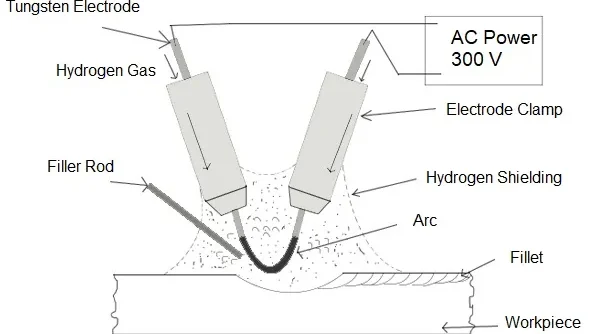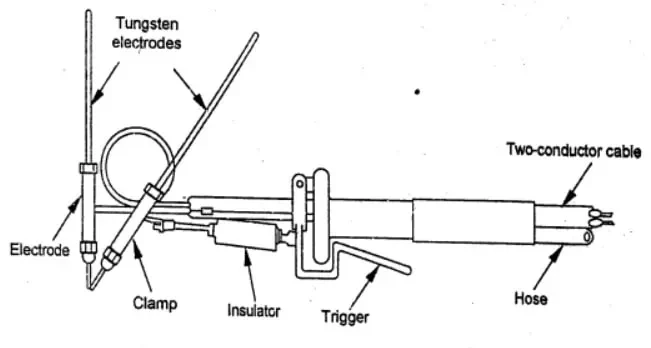Introduction to Atomic Hydrogen Welding
Definition
Atomic Hydrogen Welding (AHW) is a welding process that utilizes atomic hydrogen to achieve the high temperatures required for welding. This method leverages the unique properties of hydrogen to create a stable, high-temperature welding environment that is capable of fusing a wide range of metals.
History of Invention
The process was invented by Dr. Irving Langmuir, an American physicist and chemist, in the 1920s. Langmuir, a Nobel Prize laureate, discovered that when hydrogen molecules are dissociated into atoms in an electric arc and then recombine, they release a significant amount of heat. This heat can be harnessed to melt metals and create strong, precise welds.
Purpose and General Applications
AHW is primarily used for welding high-melting-point metals that are difficult to weld using conventional methods. Its applications span various industries, including aerospace, defense, and specialized manufacturing. The process is valued for its ability to produce high-quality, durable welds with minimal impurities and oxides.
Working Principle of Atomic Hydrogen Welding

Heat Generation Mechanism from Atomic Hydrogen
In AHW, hydrogen gas is passed through an electric arc struck between two tungsten electrodes. The electric arc dissociates the hydrogen molecules (H₂) into atomic hydrogen (H). When these hydrogen atoms recombine to form molecular hydrogen, they release a tremendous amount of heat, with temperatures reaching up to 4000°C (7200°F).
The Process of Dissociation and Recombination of Hydrogen
The dissociation of hydrogen molecules into atoms occurs in the high-temperature environment of the electric arc. These atomic hydrogen particles, when they recombine into molecular hydrogen outside the arc, release energy in the form of heat. This heat is then used to melt the metal workpieces at the weld zone, facilitating the welding process.
Formation and Protection of the Weld Zone
The recombination of atomic hydrogen not only provides the heat necessary for welding but also creates a protective atmosphere around the weld zone. This protective environment helps prevent oxidation and contamination of the weld, ensuring a clean and strong weld joint.
Advantages of Atomic Hydrogen Welding

Ability to Weld Hard-to-Melt Metals
One of the most significant advantages of Atomic Hydrogen Welding is its ability to weld metals that are challenging to melt with conventional methods. Metals such as tungsten, molybdenum, and tantalum, which require extremely high temperatures to fuse, can be effectively welded using AHW due to the intense heat generated by the recombination of atomic hydrogen.
Quality and Durability of the Weld
The high temperatures achieved in AHW result in deep penetration and strong welds. The process ensures a consistent and uniform heat distribution, which contributes to the structural integrity and durability of the welded joint. This makes AHW suitable for critical applications where weld quality is paramount.
Minimal Production of Oxides and Impurities
The hydrogen atmosphere in AHW acts as a shielding gas, preventing the formation of oxides and other impurities in the weld zone. This results in cleaner welds with fewer defects, reducing the need for post-weld treatments and enhancing the overall quality of the weld.
Applications of Atomic Hydrogen Welding
Aerospace Industry
In the aerospace industry, the ability to weld high-strength, heat-resistant metals is crucial. AHW is used to manufacture and repair components such as turbine blades, engine parts, and structural elements that require precision and resilience at high temperatures.
Defense Industry
The defense sector benefits from AHW for the fabrication and maintenance of military equipment and vehicles. The process is ideal for welding armor plating, weapon systems, and other components that must withstand extreme conditions and stresses.
Medical Instruments and Electronic Devices
The precision and quality of AHW make it suitable for manufacturing medical instruments and electronic devices. Components that demand high accuracy and minimal contamination, such as surgical tools and electronic connectors, are often welded using this method.
Special Machinery Components
Industries that produce specialized machinery and equipment also utilize AHW. This includes the production of custom machine parts, high-performance tools, and components for heavy-duty industrial applications, where reliability and durability are essential.
Related Equipment and Technology

Structure of Atomic Hydrogen Welding Machines
- Power Supply: The power supply provides the necessary electrical energy to generate the electric arc between the tungsten electrodes.
- Tungsten Electrodes: These are used to create the electric arc. Tungsten is chosen for its high melting point and electrical conductivity.
- Hydrogen Supply System: This system delivers hydrogen gas to the welding zone, where it is dissociated into atomic hydrogen by the electric arc.
- Control Unit: The control unit regulates the flow of hydrogen gas and the electrical parameters of the welding process, ensuring consistent and precise operation.
Advances in Welding Technology
- Automation: Advances in automation have enabled more efficient and consistent AHW processes. Automated systems can control the welding parameters with high precision, reducing human error and increasing productivity.
- Robotics: The integration of robotics into AHW allows for the welding of complex geometries and hard-to-reach areas. Robots can perform repetitive welding tasks with high accuracy, improving overall quality and efficiency.
Comparison with Other Welding Methods
TIG (Tungsten Inert Gas) Welding
- Advantages: TIG welding, like AHW, uses a tungsten electrode but relies on an inert gas (such as argon) to shield the weld area. It is known for producing high-quality, precise welds, and is often used for welding thin sections of stainless steel and non-ferrous metals such as aluminum, magnesium, and copper alloys.
- Disadvantages: TIG welding generally operates at lower temperatures compared to AHW, making it less suitable for welding extremely high-melting-point metals. It is also a slower process and requires a higher skill level.
MIG (Metal Inert Gas) Welding
- Advantages: MIG welding is faster and more efficient for welding thicker materials and larger projects. It uses a continuously fed wire electrode and an inert gas to protect the weld pool. It is often used in industries such as automotive, construction, and manufacturing.
- Disadvantages: While MIG welding is efficient for many applications, it does not achieve the same level of precision and cleanliness as AHW. It can also be less effective for welding thin materials and does not handle high-melting-point metals as well.
Comparison in Terms of Temperature and Cost
- Temperature: AHW reaches temperatures up to 4000°C, significantly higher than TIG and MIG welding. This makes it uniquely suited for welding metals that require very high temperatures.
- Cost: AHW tends to be more expensive due to the cost of hydrogen gas and the complexity of the equipment. However, the superior quality and durability of the welds can justify the higher costs in critical applications.
Safety and Maintenance in Atomic Hydrogen Welding
Safety Measures
- Hydrogen Control: Hydrogen is highly flammable, so proper storage, handling, and control of hydrogen gas are crucial to prevent leaks and potential explosions.
- Protection from Thermal Radiation: The high temperatures generated in AHW can produce intense thermal radiation. Welders must use protective clothing, shields, and eye protection to safeguard against burns and eye damage.
Maintenance and Inspection Procedures
- Regular Maintenance: Regular maintenance of the welding equipment, including the power supply, electrodes, and hydrogen supply system, ensures consistent performance and prolongs the life of the equipment.
- Inspection: Routine inspections help identify wear and tear, leaks, and other potential issues. Ensuring that all components are in good working condition is essential for safe and effective welding operations.
Conclusion
Summary of the Importance of Atomic Hydrogen Welding
Atomic Hydrogen Welding plays a critical role in industries that require high-precision, high-temperature welding. Its ability to weld difficult metals with high-quality, durable results makes it indispensable for applications in aerospace, defense, medical instruments, and specialized machinery.
Future of Atomic Hydrogen Welding Technology
The future of AHW looks promising with ongoing advancements in automation and robotics. These technologies are expected to further enhance the efficiency, precision, and safety of the welding process, opening up new possibilities for its application.
Recommendations for Research and Industrial Applications
Continued research into materials science, welding techniques, and equipment technology will help optimize AHW processes and expand its use. Industries should consider investing in AHW for applications that demand the highest standards of weld quality and reliability.
Leave a Reply